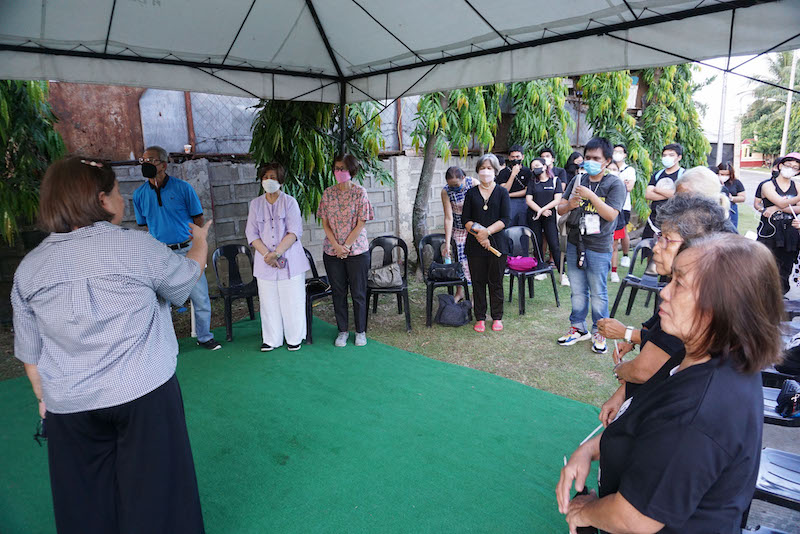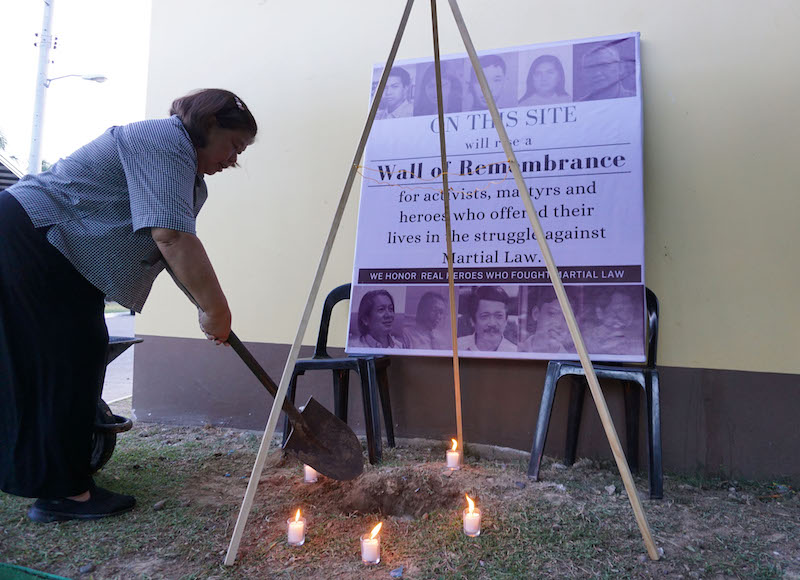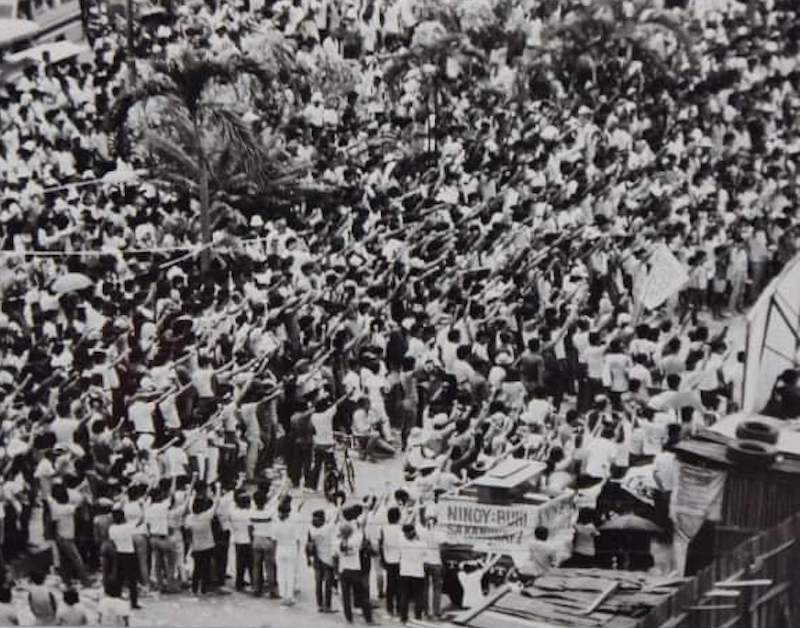Wall of Remembrance launched in Davao City to honor heroes vs Marcos dictatorship
DAVAO CITY (MindaNews / 21 September) – A “Wall of Remembrance” to honor heroes who fought the Marcos dictatorship was launched at the Forest Lake Premier memorial park here on Wednesday, September 21, to commemorate the 50th anniversary of the declaration of Martial Law by then President Ferdinand Edralin Marcos, father of the incumbent President.
Malu Lopez, who spearheaded the project, told MindaNews that when her late husband, Joel Cecilio Ozarraga Jose, was honored as a martyr in the Bantayog ng mga Bayani Wall of Remembrance in Quezon City in 2016, “I made a promise that I will initiate a Wall of Remembrance in Davao for those in the Resistance against Martial Law.”

Lopez and other activists from her generation gathered at the site at 4 p.m. Young activists were also present to witness the groundbreaking and the laying of the capsule that contained names of activists, heroes and martyrs who resisted the dictatorship.
The Wall of Remembrance is “for activists, martyrs and heroes who offered their lives in the struggle against Martial Law.”
According to the tarpaulin printed for the occasion, “we honor real heroes who fought Martial Law.”
Mindanao suffered the most number of human rights violations under the Marcos dictatorship. Protest actions were mounted by multisectoral groups in various parts of Mindanao as hundreds were harassed, arrested, detained, tortured, became desaparecidos or were killed, some of them buried in cemeteries and memorial parks, while others were buried in graves that have not been found until today.
Like their counterparts in Manila and Cebu and other parts of Mindanao, student activists in Davao City took to the streets in protest of the policies laid down by Marcos Sr. even before he declared martial law in September 1972.

The First Quarter Storm in 1970 swept across the land and in Davao City, student activists took the lead. Among the first victims of human rights violations was student activist Edgar Ang Sinco of the University of Mindanao and Samahang Demokratikong Kabataan (SDK) who was killed while delivering a speech during a protest action on February 16, 1971. He was only 19 years old.
Marcos’ declaration of martial law drove many of the city’s activists to the hills.
The first pastoral letter against human rights violations in the Marcos regime came from this city in 1978. “The Reign of Terror in the Countryside” was written by Davao Archbishop Antonio Mabutas, an Ilocano himself like Marcos. Marcos sent his Deputy Minister of Defense, Carmelo Barbero to investigate the massacre of church workers in Catalunan, the relatives of the victims represented by Prospero Nograles and Jesus Dureza, then President and Secretary of the Integrated Bar of the Philippines. They would be the first Dabawenyos to be called “human rights lawyers.”
“Killing Fields”
Under Marcos’ rule, Davao City became known as the country’s “Killing Fields” and what the military described as the “laboratory for urban guerrilla warfare” of the Communist Party of the Philippines as the city hosted the New People’s Army’s “Sparrow Unit.”
In 1985 one killing a day was no longer news in the city. There was one day in March when 12 persons were reported killed.

Also in 1985, when one saw a crowd gather at Bankerohan Bridge (now Generoso), their arms on the railings and looking down at the river below (it was just one bridge then), the jeepney or taxi driver would stop to ask only one question: “pila ka bala, ‘bay?’ (how many bullets, buddy?)
When the answer was “isang bala lang” or the index finger, the Sparrow Unit did it. It had to be a sure hit to save on bullets.
When the answer was more than one bullet, the military or police did it. They had no need to save on bullets. There were more in Marcos’ arsenal. When the dead body was hogtied, tortured or stabbed several times, the military or police did it. Sparrows operated swiftly. They had no time to tie or torture a victim.
Arrested, killed
Like in other parts of the nation, the assassination of former Senator Benigno “Ninoy” Aquino on August 21, 1983 emboldened more residents in the city to join the Parliament of the Streets, openly defying the Marcos dictatorship.
Fr. Rudy Malasmas of the Society of Jesus, then in charge of the Ateneo de Davao University’s grade school and high school, recalled in an essay published in the book “Turning Rage into Courage: Mindanao under Martial Law,” that what became the Yellow Friday Movement in the city started as a motorcade of only six vehicles.

Among the Yellow Friday leaders was Soledad Roa Duterte, mother of former President Rodrigo Duterte. Soledad was named OIC Vice Mayor after the Marcoses were ousted in February 1986 but he suggested instead her son, Rodrigo, paving the way for the government prosecutor’s entry into local politics, first as OIC Vice Mayor, Mayor for seven terms, Congressional District Representative for one term, Vice Mayor for one term and the Presidency in 2016. He stepped down as President on June 30, 2022.
Among the hundreds arrested by the Marcos dictatorship in Davao City were Karl Gaspar in March 1983 and human rights lawyers Laurente C. Ilagan, Antonio B. Arellano and Marcos D. Risonar in May 1985. Gaspar, now a Redemptorist Brother, was released in February 1985 while the three lawyers were released after the Marcoses fled Malacanang in February 1986.
Ilagan succumbed to cancer in November 2001 while Risonar also succumbed to cancer in June 2017. Arellano is a retired government prosecutor who was among those appointed by President Rodrigo Duterte to the 25-member Consultative Committee in January 2018 to review the 1987 Constitution and submit recommendations within six months. Duterte was then pushing for a shift to a federal system of government.

Among those killed in Davao City were Alex Orcullo, a newspaper columnist and radio commentator, who was gunned down in his car while on his way home to Mandug on October 19, 1984. He was with his wife and youngest son when shot dead on his 38th birthday. His funeral was attended by hundreds of protesters who marched along the city’s main streets, prompting many to refer to him as the “Ninoy of Davao City.” Ninoy refers to the former Senator Benigno Aquino III who was assassinated on August 21, 1983 on his arrival at the airport now named after him, from a three-year exile in the United States.
A number of activists from Manila also came to Davao and were killed here. Edgar Jopson of the Ateneo de Manila University and the National Union of Students of the Philippines was killed in a raid in Skyline Subdivision here on September 20, 1982. He was 34 years old. The poet Emmanuel Lacaba was killed on March 18, 1976 in Asuncion, Davao del Norte. He was 37 years old. (Carolyn O. Arguillas / MindaNews)



No comments:
Post a Comment